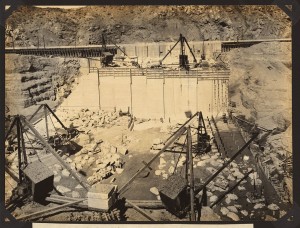Article VII of the Rio Grande Compact is one of the keys to allocating the river’s supply among Colorado, New Mexico, and Texas:
Neither Colorado nor New Mexico shall increase the amount of water in storage in reservoirs constructed after 1929 whenever there is less than 400,000 acre feet of usable water in project storage….
Operationally, this is critical. It means that in drought conditions, irrigators cannot store spring runoff in essentially all upstream reservoirs for summer use. There’s been some flexibility written into the law in practice, but it only operates at the margin. It basically means that during droughts, one of the water managers’ most important tools (storage) is constrained.

Elephant Butte Dam site: foundation of dam in bed of river, third section in foreground under construction, looking west, 1914 Feb. 27, courtesy Library of Congress
If my records are correct (and don’t hold me to the date, this is me looking up stuff in my files on a Sunday morning without benefit of actually confirming with people who know, i.e. “doing journalism”), we’ve been in Article VII since July 8, 2010. But with the big last-of-Februrary-first-of-March storm, there are signs usable project storage in Elephant Butte Reservoir could rise above the magic 400,000 acre feet some time around the first of May. That would allow the Middle Rio Grande Irrigation District to sock away a bit of extra water for late summer alfalfa cuttings.
The variables here illustrate the way a big reservoir integrates across both supply and demand functions. As soon as the Elephant Butte Irrigation District downstream begins taking its water out of Elephant Butte, it’ll likely drop back below 400k and we’ll be back in Article VII. The current “official” date for the start of irrigation is June 1, but it looks like it may be earlier – like the middle of May. Depending on runoff between now and then, EBID’s start might even slip earlier, which would trigger the usual “black helicopters” north-south water war trope about how EBID and the federal government are in cahoots to keep Article VII storage restrictions in place.
I am generally skeptical of black helicopters.

re: Storage on the Rio Grande. Good job on this issues. FYI Sen. Tom Udall’s “drought relief” bill (2014) calls for the National Academy of Sciences to convene a panel to study reservoir operations on the Rio Grande. If you look at all that has transpired since the listing of the Rio Grande Silvery Minnow, storage is the biggest of all the convoluted issues facing water managers in NM. A footnote: As you know, the Middle Rio Grande Conservancy District is not, technically or legally, and “irrigation district.” That’s why “irrigation” does not appear in its name, but is instead one of three legal purposes for it’s existence, drainage and flood control being the other two.
Sterling – Thanks for the comment, I think tweaking storage rules is one of the most important and interesting things we can do, and one of the most politically challenging? I’d love your thoughts about those challenges.
I love your comment about MRGCD not being an “irrigation district.” I tossed off that line without really thinking about it, and of course your are correct. But in practice, the agency’s entire operational focus right now is (nearly) entirely on irrigation. So maybe I’ll keep describing ’em that way anyway.
Pingback: Bloggers Tackle Water Project Financing, Groundwater Management, Water Supplies & Drought, Climate Change, Megadrought and more
Pingback: A glimmer of good water supply news for New Mexico’s middle Rio Grande farmers | jfleck at inkstain